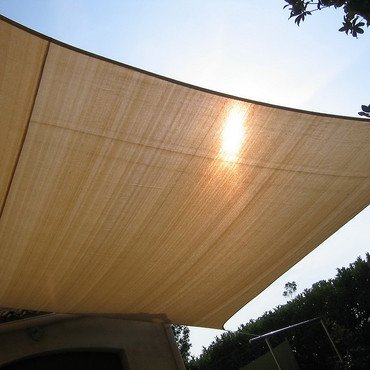The Sail Shade Boutique - UK
UV protection from the Australian specialistsWhat is a sail shade
|
|
Created as part of the Australian government initiative to reduce skin cancer rates in their country, the modern shade sail was born in the 1960's. A new fabric (HDPE) was developed by the Australian company Gale Pacific. This new fabric absorbs and blocks the sun's harmful UV rays so for the first time a fabric creating shade could also block UV.
Gale Pacific is the parent company of Coolaroo. Using the new HDPE fabric Coolaroo was created to develop the uses of the HDPE fabric and they remain the worlds leading HDPE manufacturer today. Their products include shade sails and exterior blinds, both of which block the suns harmful UV rays. The modern shade sail essentially consists of a woven HDPE fabric which is stretched between three or more anchor points. At each anchor the shade sail has a strong metal fixing which can be attached to tensioners to stretch the fabric taught. The sides of the shade sail are reinforced to give the structure the necessary strength and the sides are curved to allow the necessary stretching to take place. Once installed the fabric will make a semi rigid structure. Stretching the shade sail is important as, like a ships sail, the large surface area of the modern shade sail will be affected by the wind. Once stretched the fabric creates a rigid structure and the shade sail will not move. Modern shade sails are growing in popularity worldwide. In many warmer environments, such as parts of Australia and South Africa, people leave their shade sail permanently in place. In many other countries, notably those with season weather variations, shade sails are generally only left in place during the summer months. There main reasons for this are :
Modern shade sails are gaining in popularity for both residential and commercial installations. They are particularly, but not exclusively, popular for proving protected shade where ever children play. They can often be found protecting play areas, the gardens , creches and nurserys, , school playgrounds, outdoor swimming pool areas and many other settings. In residential environments they often also cover outdoor eating and seating areas. The modern shade sail are unique amongst shade solutions in that their main design feature is not only but also to give the maximum possible protection from the sun's harmful UV rays. We now now that the sun's UV rays are responsible for problems ranging from sunburn to being a significant risk factor for skin cancer. |
|
The origins of the shade sail date back thousands of years when sailors would use their boat sails to create shade during the hottest parts of the day. The improtu use of sails in this way probably dates from the origins of sailing.
The first organised use of boat sails to provide protection from the sun first appear in historical documents from Roman times. Anecdotal evidence suggests that the use of sails for this purpose was practiced for many years before, especially in Greece. According to the documents, the Romans often commandeered boat sails to provide much needed shade during festivals, organised events and for any large gathering of people. Large, communal events such as those at the Colosseum in Rome often used sails to create shade in this manner. Perhaps one of the first uses was by beached sailors, where finding shade could often be a matter of life and death. If the sails from a ship survived, then beached sailors could make a quick and easy shelter to protect them in the hottest parts of the day. |

|
|
The popularity for the new style of shade sails began in Australia in the late 1960’s and early 1970’s following the invention of the first UV resistant HDPE fabric by Coolaroo’s parent company, Gale Pacific. Still the market leader today, their revolutionary fabric has undergone continuous improvement to give customers the very best UV block. Thanks to Coolaroo, shade sails are now rumored to be more numerous in Australia than kangaroos!
While shade sail installations vary, in the residential setting they are most commonly fixed to side of the house and to either a post in the garden a prexisting sturdy fixing point (perhaps even a sturdy tree). They are used to create a shaded area for swimming pools, spas, barbecues, patios and play areas for children. They are also frequently used to create car ports to protect vehicles from the suns hat. Shade sails are increasingly used commercially to provide shade in malls and parking lots and they are used extensively in all outside areas where children may play. |
|

|
|
|
Shade sails offer proven protection from the sun harmful ray, allow people enjoy spending time relaxing outdoors. In Australia, shade sails have been made mandatory in some locations such as schools, kindergartens, and corporations.
Shade sails offer a far more affordable shade solution than gazebos, pergolas and other solid structures. Our shade sails require little maintenance and are very durable providing long lasting UV protection |
|
|
The initial concept of the shade sail is to protect from the sun’s harmful rays and to create as comfortable an environment as possible in hot weather. Our shade sails are made of knitted HDPE strands which allows air to pass through the sail, ensuring that hot air is not trapped underneath the canopy and that those below can benefit from any breezes. As the fabric is knitted to allow air to pass through, the fabric is not completely waterproof. In practice, however, as long as the shade sail is not installed flat, then the vast majority of the rain will flow off of the sides.
Good quality waterproof shade sails are available on the market, but these will trap hot air beneath, creating a shaded area up to 5 degrees warmer than the surrounding area. | |
|
Our shade sails are made by market leading Australian manufacturers. These shade sails offer customers long lasting protection against the sun, which has been proven over many years in Australia's harsh climate.
To order your shade sail simply select the required range, form, size and colou you require then proceed to the paypal secure payment system where you can pay with any bank card or by using your paypal account if you have one. Once payment has been made, your shade sail will be dispatched within 2 working days. |
